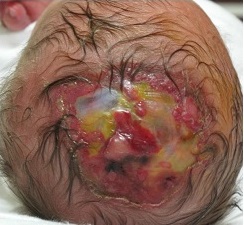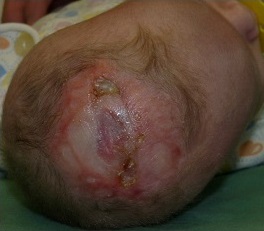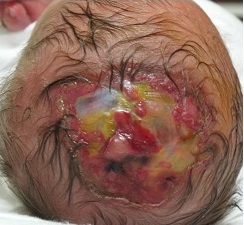|
Scalp Defect
Albahri Z1, Krylova K1, Al Mawiri A2, Bartonova J3, Stefackova S4, Docekalova S5.
1Department of Pediatrics, Faculty hospital, Charles University in Hradec Kralove, Czech Republic,
2Department of Internal Medicine, Faculty hospital, Charles University in Hradec Kralove, Czech Republic,
3Department of Pediatric Dermatology, Faculty hospital, Charles University in Hradec Kralove, Czech Republic,
4Department of Neurology, Faculty hospital, Charles University in Hradec Kralove, Czech Republic,
5Department of Pediatric Surgery, Faculty hospital, Charles University in Hradec Kralove, Czech Republic.
ADDRESS FOR CORRESPONDENCE
Ziad Albahri, MD, PhD, Department of Pediatrics, Faculty hospital, Charles University in Hradec Kra´love´, Sokolska´ 581, 500 05 Hradec Králove´, Czech Republic.
Email: marziadmar@seznam.cz
Figure 1: At presentation on Day 1 of life

Figure 2: On follow up at 2 months of age

|
Figure 1: At presentation on Day 1 of life

|
What is the diagnosis?
Aplasia cutis congenita {ACC}. It is a rare disease of unknown etiology, usually affects the scalp {up to 84 percent}, but any part of the body may be affected, most commonly presents as a solitary defect, can have variable extent ranging from 0.5 to 10 cm or more. It is reported that only 15 to 20 percent of cases of scalp ACC are associated with an underlying bony defect. {1} ACC affecting large portions of the scalp { More than 3 × 5?cm} are very rare. In the cases of extensive scalp ACC, it was reported that 75 percent had skull defects. CNS malformations with ACC are rare. Non-scalp lesions may involve the trunk and, or extremities, and may be associated with epidermolysis bullosa or other congenital anomalies. {2} Complications of large scalp ACC with bony defect include sagittal sinus hemorrhage or thrombosis, site infection or meningitis. Mortality has been estimated to be as high as 25 to 55 percent. Clinical manifestation of intractable seizures and developmental delay are reported. {3} Our patient presented with an extensive area of scalp ACC large underlying bone defect without CNS malformation. No family history of similar condition and no history of medications {alcohol or drugs} or disease during pregnancy could be elicited in our patient. The patient`s skin and bone defects were treated with conservative dressing , with gradual epithelialization, no complications of infection or thrombosis were noted. By 1.5 year of age, the area of ACC was well-healed and the underlying parietal bone partially ossified. Clinical examination at 18 months revealed normal growth and development, neurologically, the infant had no obvious deficit. Most lesions of ACC heal spontaneously with conservative dressing, small areas of ACC usually heal well with alopecic scars and with no residual problems, but large lesions may necessitate surgical interference with skin grafts or local skin flaps. {4} |
| |
| Compliance with ethical standards |
|
Funding: None
|
|
|
Conflict of Interest: None
|
|
- Burkhead A, Poindexter G, Morrell DS. A case of extensive Aplasia Cutis Congenita with underlying skull defect and central nervous system malformation: discussion of large skin defects, complications, treatment and outcome. J Perinatol. 2009;29:582-584 [CrossRef] [PubMed]
- Evers ME, Steijlen PM, Hamel BC. Aplasia cutis congenita and associated disorders: an update. Clin Genet 1995;47: 295-301. [CrossRef] [PubMed]
- Maillet-Declerck M, Vinchon M, Guerreschi P, Pasquesoone L, Dhellemmes P, Duquennoy-Martinot V, et al. Aplasia cutis congenita: review of 29 cases and proposal of a therapeutic strategy. Eur J Pediatr Surg. 2013;23:89-93 [PubMed]
- Blunk K, Quan V, Carr C. Aplasia cutis congenita: a clinical review and associated defects. Neonatal Network. 1992;11:17-27.
|
|
DOI: https://doi.org/10.7199/ped.oncall.2015.42 |
| |
Cite this article as:
Z A, K K, A A M, J B, S S, S D. Scalp Defect (Giant Aplasia Cutis Congenita of the Scalp in a Newborn). Pediatr Oncall J. 2015;12: 91. doi: 10.7199/ped.oncall.2015.42
|